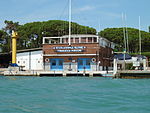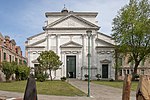Sant'Andrea (Venetian Lagoon)
Islands of the Venetian Lagoon

Sant'Andrea is a small island in the Venetian Lagoon, northern Italy. It houses the Forte di Sant'Andrea, a large fortress built in the 16th century to defend Venice. Sant'Andrea constitutes a prolongation of the island of Vignole, from which it is separated by a narrow channel, towards the Porto di Lido-San Nicolò on the Lido, between Venice's Island and the island of Sant'Erasmo.
Excerpt from the Wikipedia article Sant'Andrea (Venetian Lagoon) (License: CC BY-SA 3.0, Authors, Images).Sant'Andrea (Venetian Lagoon)
Riviera San Nicolò, Venice Lido-Pellestrina
Geographical coordinates (GPS) Address Nearby Places Show on map
Geographical coordinates (GPS)
| Latitude | Longitude |
|---|---|
| N 45.434602 ° | E 12.381146 ° |
Address
Forte di Sant'Andrea
Riviera San Nicolò
30132 Venice, Lido-Pellestrina
Veneto, Italy
Open on Google Maps






